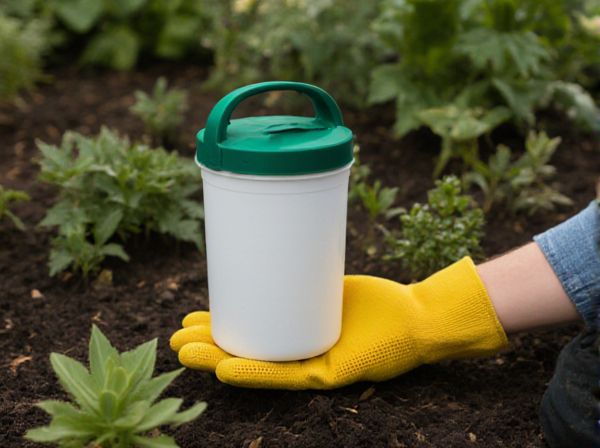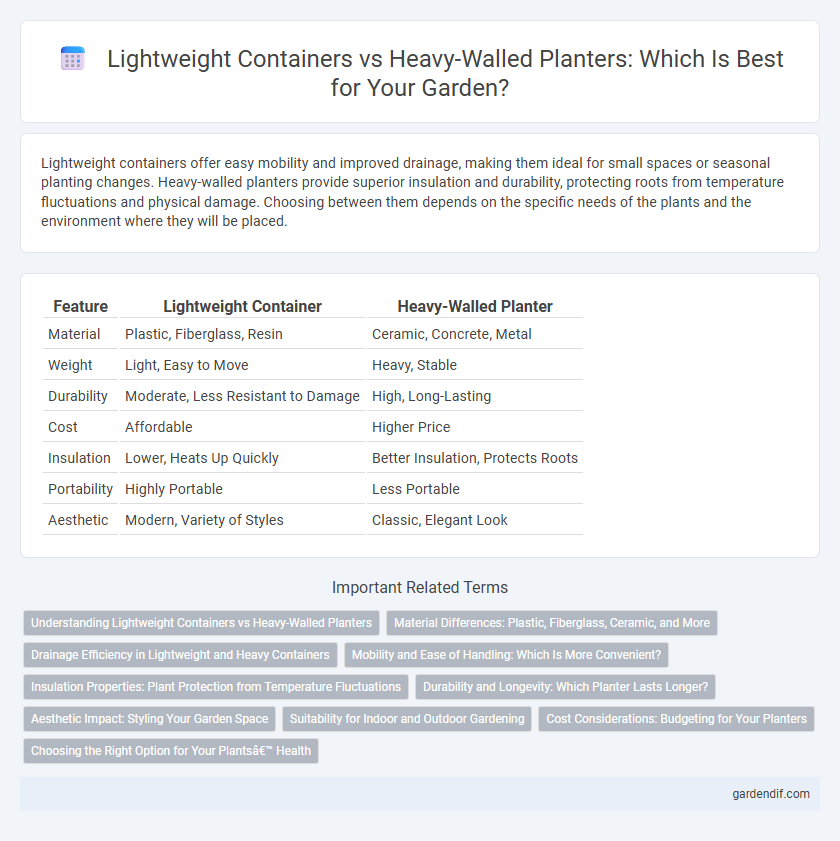
Lightweight container vs heavy-walled planter Illustration
Lightweight containers offer easy mobility and improved drainage, making them ideal for small spaces or seasonal planting changes. Heavy-walled planters provide superior insulation and durability, protecting roots from temperature fluctuations and physical damage. Choosing between them depends on the specific needs of the plants and the environment where they will be placed.
Table of Comparison
| Feature | Lightweight Container | Heavy-Walled Planter |
|---|---|---|
| Material | Plastic, Fiberglass, Resin | Ceramic, Concrete, Metal |
| Weight | Light, Easy to Move | Heavy, Stable |
| Durability | Moderate, Less Resistant to Damage | High, Long-Lasting |
| Cost | Affordable | Higher Price |
| Insulation | Lower, Heats Up Quickly | Better Insulation, Protects Roots |
| Portability | Highly Portable | Less Portable |
| Aesthetic | Modern, Variety of Styles | Classic, Elegant Look |
Understanding Lightweight Containers vs Heavy-Walled Planters
Lightweight containers are crafted from materials such as fiberglass, resin, or plastic, offering easy mobility and resistance to weathering, making them ideal for patios and balconies. Heavy-walled planters, typically made from ceramic, concrete, or stone, provide superior insulation and stability, supporting larger plants and reducing the risk of tipping. Understanding the balance between portability and durability helps gardeners select the right container based on plant size, environmental conditions, and aesthetic preferences.
Material Differences: Plastic, Fiberglass, Ceramic, and More
Lightweight containers are primarily made from plastic and fiberglass, offering durability, ease of transport, and resistance to cracking, while heavy-walled planters often use ceramic or clay materials that provide excellent insulation and aesthetic appeal but add significant weight and fragility. Plastic containers feature UV resistance and water retention properties, whereas fiberglass offers a robust yet lightweight alternative that mimics the look of heavier materials. Ceramic and other heavy-walled planters provide a stable environment for root systems but require careful handling due to their brittleness and weight.
Drainage Efficiency in Lightweight and Heavy Containers
Lightweight containers often feature enhanced drainage systems such as multiple, larger holes and aerated materials to prevent waterlogging and promote root health. Heavy-walled planters, while sturdy, usually have fewer drainage options and can retain excess moisture, increasing the risk of root rot. Efficient drainage in lightweight containers improves overall plant growth by maintaining optimal soil oxygen levels and preventing excess water accumulation.
Mobility and Ease of Handling: Which Is More Convenient?
Lightweight containers offer superior mobility and ease of handling compared to heavy-walled planters due to their reduced weight and ergonomic designs, facilitating effortless rearrangement and transportation. Heavy-walled planters, often made from concrete or ceramic, provide durability but require more effort and sometimes specialized equipment for movement, limiting their convenience. For frequent repositioning and garden redesigns, lightweight containers provide a practical advantage in terms of convenience and flexibility.
Insulation Properties: Plant Protection from Temperature Fluctuations
Lightweight containers often feature materials such as plastic or fiberglass, which provide minimal insulation and expose plant roots to greater temperature fluctuations. Heavy-walled planters, typically made from terracotta, ceramic, or concrete, have superior thermal mass that stabilizes soil temperature and protects plants from extreme heat or cold. This insulation property reduces stress on plants, promoting healthier growth during seasonal temperature changes.
Durability and Longevity: Which Planter Lasts Longer?
Lightweight containers, typically made from materials such as fiberglass, resin, or plastic composites, offer good resistance to weather but may degrade faster under prolonged sun exposure and temperature fluctuations. Heavy-walled planters constructed from concrete, ceramic, or stone provide superior durability and longevity due to their thicker walls and robust materials that withstand environmental stress without cracking or warping. The longevity of heavy-walled planters generally surpasses that of lightweight containers, making them a more durable option for long-term outdoor use.
Aesthetic Impact: Styling Your Garden Space
Lightweight containers offer sleek, contemporary designs that enhance modern garden aesthetics with clean lines and vibrant colors, creating a visually dynamic space. Heavy-walled planters provide a classic, substantial look, adding texture and a sense of permanence that complements traditional garden styles. Choosing between lightweight and heavy-walled containers depends on the desired visual impact, from minimalist elegance to bold architectural elements.
Suitability for Indoor and Outdoor Gardening
Lightweight containers made from materials like plastic or fiberglass offer portability and ease of handling, making them ideal for indoor gardening where frequent movement is required. Heavy-walled planters, such as those made from ceramic or concrete, provide greater stability and insulation, making them well-suited for outdoor environments exposed to wind and temperature fluctuations. Choosing the right container depends on balancing factors like durability, weight, and the specific needs of indoor versus outdoor plants.
Cost Considerations: Budgeting for Your Planters
Lightweight containers offer cost-effective solutions due to lower material and shipping expenses compared to heavy-walled planters, which often require more durable, expensive materials such as thick ceramics or concrete. When budgeting for planters, consider the initial purchase price along with long-term maintenance and replacement costs; heavy-walled planters may last longer but can incur higher upfront investment and labor costs. Choosing between lightweight and heavy-walled options hinges on balancing budget constraints with durability needs and placement requirements.
Choosing the Right Option for Your Plants’ Health
Lightweight containers offer excellent drainage and portability, making them ideal for small to medium-sized plants that require frequent watering and repositioning. Heavy-walled planters provide superior insulation and durability, supporting larger plants by maintaining consistent soil temperature and moisture levels. Selecting the right container depends on plant species, root structure, and environmental factors to optimize growth and overall health.
Lightweight container vs heavy-walled planter Infographic

 gardendif.com
gardendif.com